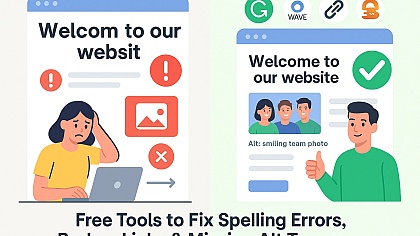
Web Design as an Important Aspect for SEO
A visually impressive website is only half the battle. If your site isn’t properly optimised, your audience may never find it—no matter how good it looks. That’s why optimising your site for search engines should be considered from the very beginning of the web design process. The way your site is structured, built and presented has a direct impact on how search engines crawl, understand and rank your pages.
Let's take a look at why web design is a crucial element of SEO, how design decisions influence search visibility, and what you can do to create a site that both users and search engines love.
What It Is / Why It Matters
What Is the Relationship Between Web Design and SEO?
Web design involves everything from layout and visual identity to technical performance. SEO, meanwhile, focuses on improving your site’s visibility in search results. While they may appear separate, they are deeply interconnected.
Poor design—slow loading pages, confusing navigation, or content hidden behind scripts—can significantly reduce your ranking potential. Search engines prioritise user experience, and design plays a central role in delivering it.
For a deeper overview of how search engines evaluate websites, you can check out Google’s SEO Starter Guide.
Why It Matters
Search engines increasingly measure real user behaviour. Strong web design supports positive engagement signals such as:
- Fast page loading
- Low bounce rates
- High time on site
- Logical navigation
- Mobile-friendly experiences
According to research from HubSpot, UX-driven design contributes significantly to organic growth, making it essential that design supports—not hinders—SEO.
Benefits, Challenges & Best Practices
Benefits of SEO-Friendly Web Design
A design strategy aligned with SEO offers long-term advantages:
- Higher organic visibility: Better structure, clean code and strategic layout help search engines crawl and index your site.
- Improved user engagement: Faster, easier-to-navigate websites keep users on the page longer.
- Greater credibility: Professional, accessible design builds trust and supports conversions.
- Better conversion rates: Users who find what they need quickly are more likely to take action.
Challenges to Be Aware Of
Combining design and SEO isn’t always straightforward:
- Design-first builds can ignore SEO: Looks alone won’t get you ranked.
- Overuse of heavy animations or scripts can slow performance dramatically.
- Navigation mistakes, like too many nested pages or inconsistent structure, confuse both users and search engines.
- Poor mobile experience can hurt rankings, especially since Google uses mobile-first indexing.
Best Practices for SEO-Driven Web Design
Below are proven methods to ensure your design supports organic visibility:
1. Use a Clear Site Structure
- Logical page hierarchy
- Consistent navigation
- Breadcrumbs for deeper sections
This helps both users and search engines understand your pages.
2. Prioritise Fast Load Times
- Compress images
- Minify CSS and JavaScript
- Use modern hosting or CDN solutions
Speed is a confirmed ranking factor by Google.
3. Create a Mobile-First Experience
Most users now browse on mobile, and Google ranks based on mobile versions of pages. Responsive design is essential.
4. Write Clean, Semantic HTML
Well-structured HTML supports accessibility and makes crawling easier.
5. Use High-Quality Content Blocks
Typography, spacing, formatting and multimedia should make content easy to consume. Clarity is good for users—and good for SEO.
6. Optimise URLs, Images and Metadata
- Clear URLs
- Alt text for images
- Unique meta titles and descriptions
These small details play a big part in search clarity and ranking.
7. Integrate SEO into the Design Process
SEO should begin at the planning stage, not as an afterthought. Combining early keyword research, content planning, and UX strategy always produces better results.
How to Implement SEO-Friendly Web Design

Here’s a step-by-step approach to merging web design and SEO effectively:
1. Start With Keyword and Intent Research
Identify what users are looking for and map content to match these needs. Early research shapes layout, content and structure.
2. Plan the Site Architecture
Create a clean hierarchy:
- Homepage
- Main categories
- Sub-pages
- Supporting content
This structure helps search engines understand which pages are most important.
3. Build a Mobile-First Layout
Design from the smallest device upwards. This ensures:
- Fluid grids
- Responsive images
- Consistent spacing
- Touch-friendly navigation
4. Improve Page Speed
Use tools like Google PageSpeed Insights to identify performance issues such as:
- Large images
- Render-blocking scripts
- Slow server response times
Speed is a ranking factor—optimise it early.
5. Optimise Content Formatting
Use clear headings (H1, H2, H3), short paragraphs, bullet points and white space. This improves readability and helps search engines interpret page structure.
6. Strengthen Internal Linking
Connect related pages meaningfully to:
- Distribute link equity
- Improve crawling
- Help users navigate
7. Test, Audit and Refine
Use analytics tools to monitor:
- Bounce rates
- Time on page
- Mobile usability
- Organic performance
Regular reviews ensure your design remains aligned with the SEO strategy.
FAQs
1. Does web design really affect SEO?
Yes. Design directly affects speed, mobile usability, structure and UX—all of which influence search rankings.
2. Can Google see JavaScript-heavy designs?
Google can render JavaScript, but not always efficiently. Relying too heavily on JS for core content can slow crawling and reduce visibility.
3. What design element affects SEO the most?
Fast loading times and mobile responsiveness are two of the strongest SEO-related design factors.
4. Do colours and visuals affect rankings?
Not directly, but poor visual hierarchy can harm UX, leading to lower engagement metrics, which do affect rankings.
5. Should I redesign my website for SEO?
If your current site is slow, outdated or hard to navigate, a redesign can massively improve both user experience and organic performance.
Web design and SEO are deeply interconnected. A well-designed website supports visibility, engagement and conversion—while a poorly designed one can work against your SEO efforts, no matter how strong your content is.
To ensure your website performs at its best, consider integrating SEO principles into your design from the very beginning. If you're looking for expert support in optimising your site for search engines, our team can help you design a fast, intuitive and search-ready website.














